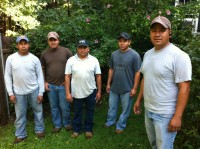Home Guru: Help! I’m Embarrassed but My Property Has Run Wild

This spring and summer, I didn’t invite anybody over to my property because I was too embarrassed, yes embarrassed. Most people who know me now associate me with The Home Guru who doles out advice about home maintenance, both inside and out.
But lately I’ve had little free time to do my usual outdoor garden chores because I’ve been exceptionally busy with the welcomed upturn in the real estate market. As a result, in the past two seasons, I have let my shrubs and ornamental trees become badly overgrown.
While I have my lawn mowed by a service, I always liked saving for myself the artistic stuff, like planting annuals and pruning my shrubs and ornamental trees into the shapes that I found more aesthetically pleasing. But aided and abetted by the damage done last year by Irene and the early winter snow storm that followed, I fell down on the job and experienced a near paralysis in even starting the huge task at hand.
Please, no cracks that allude to the proverb, “Those who can do, those who can’t teach.”
Addressing overgrowth and damage to trees and shrubs can be too daunting a task for the average homeowner who, like me, doesn’t have heavy equipment and has only limited garden tools, and even those I have are not as sharp as they should be.
But no more excuses. Let me suggest the quick solution for the challenge at hand: hire a qualified expert to help.
To the rescue is my newest best friend in saving me from total despair about the situation: Carlos Lopez, who owns a landscaping and tree removal service. Carlos was recommended to me by a client after I lost many trees in a twister during Irene. He performed an excellent clean-up at the time and for a reasonable price.
In advance, Carlos surveyed my property to give me a quote for the work, and on the appointed day arrived with his crew of four workers and an arsenal of heavy equipment: a chain saw, pruners on long poles, an electric hedge trimmer, an incredibly tall extension ladder and a shredder. Observing all the professional equipment and tools, I wondered, how could I ever have even thought about attempting the job on my own?
After a brief instruction by Carlos, the crew understood exactly what to do and went about their business clipping, buzzing, sawing and chipping away at their assignments which included: cutting down one very old but greatly damaged hemlock, shaping rows of junipers, barberries and a giant old holly (and I expect it to be a full grown tree someday, which is what happens to ancient hollies that never seem to die), thinning and shaping three gangly crabapple trees, pruning massive mounds of forsythia which had literally taken over one side of my yard, and the most vicious job of all: whacking through a jungle of wisteria that had invaded a blue juniper that is well over a hundred years old as well as a nearby crabapple that was literally choking from the boa-constrictor-like grip of the vine to its very top.
Within three quarters of a day, my property was transformed from a jungle of amorphous shapes to an orderly and attractive garden once again.
Rather than waiting for just the right season to prune and shape shrubs and trees, as horticultural experts suggest, I had it all done in late summer when I couldn’t wait a day longer.
But for those of you who have the time and spirit to prune appropriately in the right season, here is what experts suggest.
Pruning “bleeder” trees such as maple, walnut and birch is best done from late winter to early spring. The others can be done in summer. Most people think about pruning shrubs in the spring, but those that flower have already set their buds in the fall, so pruning them at the onset of spring would mean losing their blossoms. These would include such shrubs as azalea, forsythia, hydrangea, and lilac. Instead, they should be pruned immediately after blooming.
Summer flowering shrubs, such as honeysuckle, jasmine and Rose of Sharon, should be pruned in the fall or winter.
Pruning is recommended annually to help trees and plants keep their shape, to get rid of diseased wood and encourage new growth. But if time does not allow you to do it yourself, it’s well worth the price to hire an expert landscaper. To reach Carlos Lopez, call 914-424-7272.
Thank you, Carlos, for allowing me to modify that proverb to “Those who can do, those who can’t get help.”
Bill Primavera is a licensed Realtor® associated with Coldwell Banker and a lifestyles columnist who writes regularly as The Home Guru. For those seeking advice on home maintenance or who want to buy or sell a home, visit his website, www.PrimaveraHomes.com, or call him directly at 914-522-2076.


